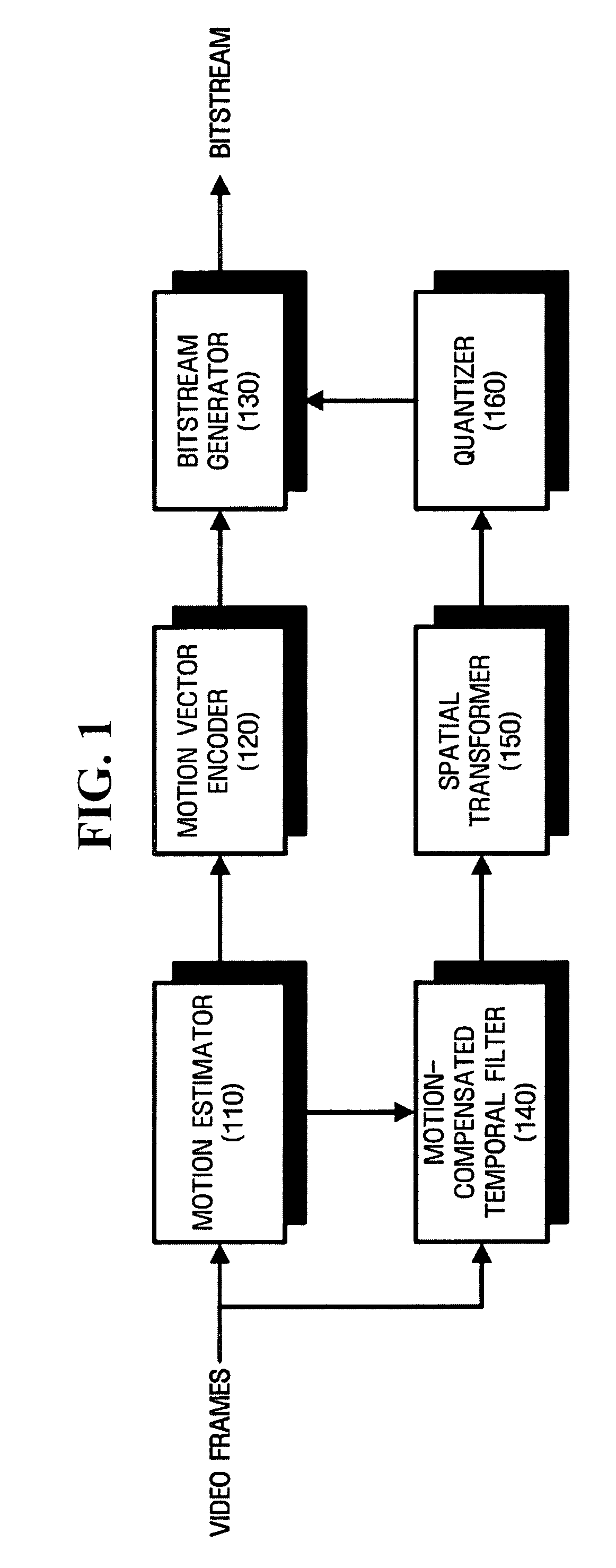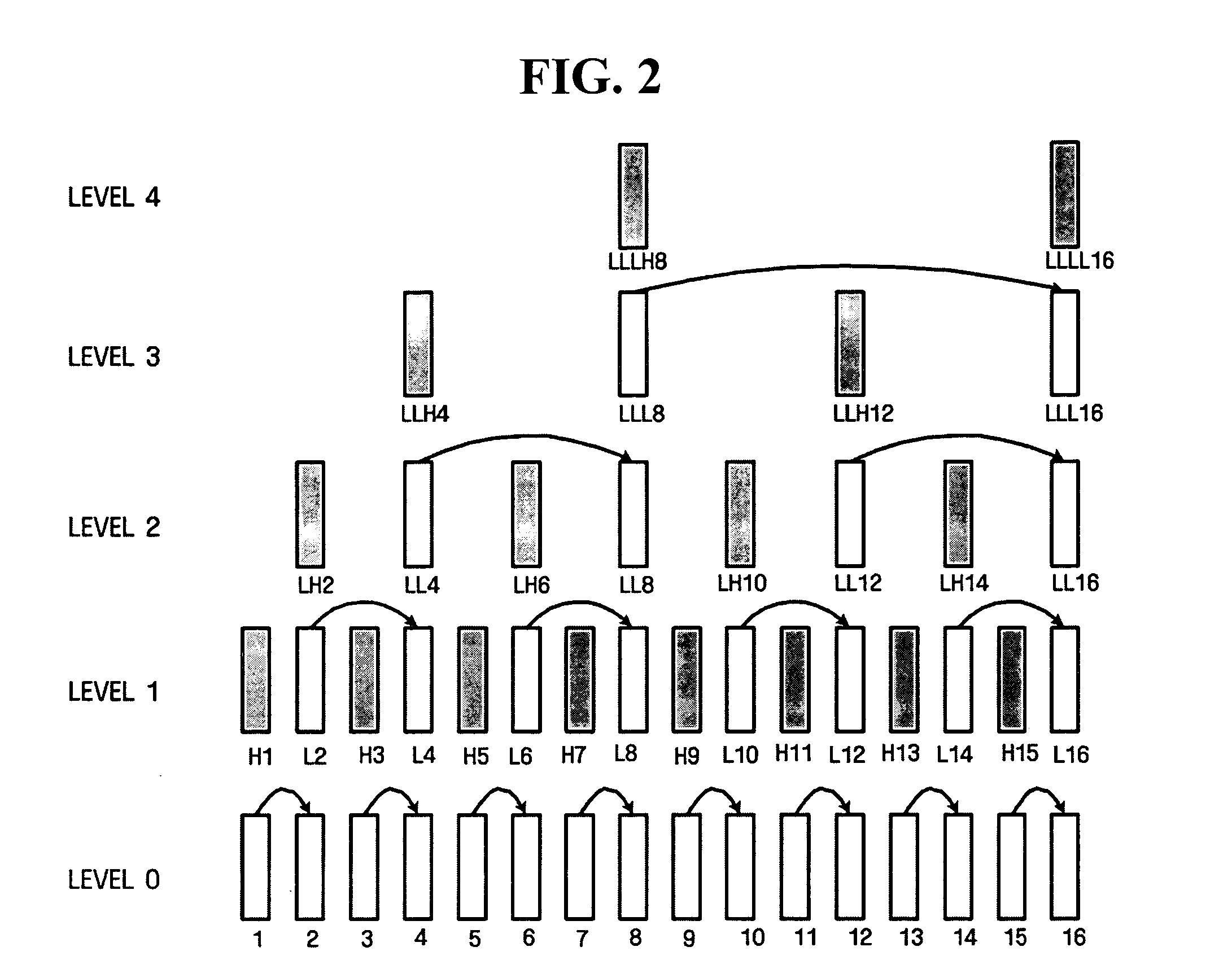Temporal decomposition and inverse temporal decomposition methods for video encoding and decoding and video encoder and decoder
- Summary
- Abstract
- Description
- Claims
- Application Information
AI Technical Summary
Benefits of technology
Problems solved by technology
Method used
Image
Examples
first embodiment
[0045]FIG. 3 is a block diagram of a video encoder according to the present invention.
[0046] Although a conventional motion-compensated temporal filtering (MCTF)-based video coding scheme requires an update step, many video coding schemes not including update steps have recently been developed. While FIG. 3 shows a video encoder performing an update step, the video encoder may skip the update step.
[0047] Referring to FIG. 3, the video encoder according to a first embodiment of the present invention includes a temporal decomposition unit 310, a spatial transformer 320, a quantizer 330, and a bitstream generator 340.
[0048] The temporal decomposition unit 310 performs MCTF on input video frames on a group of picture (GOP) basis to remove temporal redundancies within the video frames. To accomplish this function, the temporal decomposition unit 310 includes a motion estimator 312 estimating motion, a smoothed predicted frame generator 314 generating a smoothed predicted frame using mo...
second embodiment
[0065]FIG. 5 illustrates a temporal decomposition process not including an update step according to the present invention.
[0066] Like in the first embodiment illustrated in FIG. 4, referring to FIG. 5, a video encoder obtains residual frames 2H, 4H, 6H, and 8H in level 1 using frames 1 through 8 in level 0 through a predicted frame generation process, a smoothing process, and a residual frame generation process. However, a difference from the first embodiment is that the frames 1, 3, 5, and 7 in level 0 are used as frames 1, 3, 5, and 7 in level 1, respectively, without being updated.
[0067] Through a predicted frame generation process, a smoothing process, and a residual frame generation process, the video encoder obtains frames 1 and 5 and residual frames 3H and 7H in level 2 using the frames 1, 3, 5, and 7 in level 1. Likewise, the video encoder obtains a frame 1 and a residual frame 5H in level 3 using the frames 1 and 5 in level 2.
third embodiment
[0068]FIG. 6 illustrates a temporal decomposition process using a Haar filter according to the present invention.
[0069] Like in the first embodiment shown in FIG. 4, a video decoder uses all processes, i.e., a predicted frame generation process, a smoothing process, a residual frame generation process, and an update process. However, the difference from the first embodiment is that a predicted frame is generated using only one frame as a reference. Thus, the video encoder can use either forward or backward prediction mode. That is, the encoder may not select a different prediction mode for each block (e.g., forward prediction for one block and backward prediction for another block) nor a bi-directional prediction mode.
[0070] In the present embodiment, the video encoder uses a frame 1 as a reference to generate a predicted frame 2P, smoothes the predicted frame 2P to obtain a smoothed predicted frame 2S, and compares the smoothed predicted frame 2S with a frame 2 to generate a resid...
PUM
 Login to View More
Login to View More Abstract
Description
Claims
Application Information
 Login to View More
Login to View More - R&D
- Intellectual Property
- Life Sciences
- Materials
- Tech Scout
- Unparalleled Data Quality
- Higher Quality Content
- 60% Fewer Hallucinations
Browse by: Latest US Patents, China's latest patents, Technical Efficacy Thesaurus, Application Domain, Technology Topic, Popular Technical Reports.
© 2025 PatSnap. All rights reserved.Legal|Privacy policy|Modern Slavery Act Transparency Statement|Sitemap|About US| Contact US: help@patsnap.com



